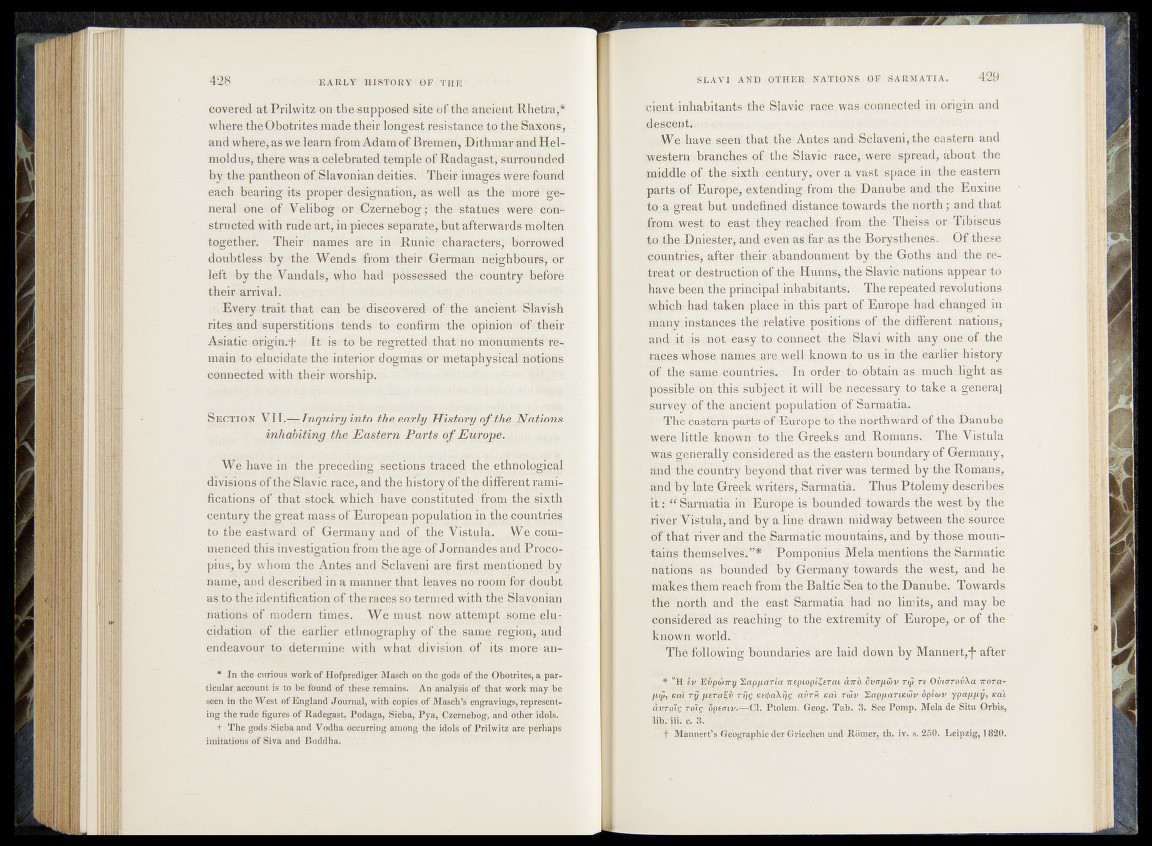
coveredat Prilwiteon thesapposed  ^ à ^ iït Rhetiö,*
where theQbotrites made their longest resistance to the SàxOnfey
and where, aswe learn from Adam of Bremen, DithmUrënd Hel-
moldusy there was a celebrated temple o fRadagàst;'sUrrou tided
by the ?pantheon:of.Slavonian deities. ! »Their imagés were found
each fearing its proper des%natiod, *as wëll' asf thé^morë ’ gëi-
neral> one ; of Velibog or :(Dzernebogftthe;istatues were constructed
with rude art, in pieces separate, but afterwards molten
together. Their names -are-in ; Runic?'characters^ borrowed
doubtless: by the Wends fiom theifM3erman äneighbours, or
left d>y the; Vandals, who had pèisæMed it,he;;côüntry, bëfôî'è
their : arrival.
- Every trait th a t can be discovered o f the ■ancieht -Sla^wh
rite§_and superstition's tends -t o ’eönfiröbthe opitfinfejöf(tffdif
Asiatic origin, ! It is- to be- regrettedvlhattnO-monuMents^‘rë*
main to elucidate the interior dogmas or metaphysical notions
connected with th eir worship. %
Section V II.—Inquiry into tk e fia r ly ^ is to r ^ f ^ ^
inhabiting the Eastern Parts o f E urope .,
We have in the preceding .sections traced the ethnological
divisions of theSlavic race, and the hjstpry of the different ramifications
of that stock which have constituted from th& sixth
century the great mass of European population in thec^oi|.ntrie|
to the eastward of* Germany and of the Vistula. We, oorru;
menced jhis investigation from the age of Jornapdes. and Procor
pius, by whom the Antes and Sclaveni are first mentioned; by
name, and described in a manner that leaves no ropm for donb,t
as to the identification of-the races so termed with the ^iafonisfi
nations of modern times-. We must now attempt jsppte elu-
cidation of the earlier ethnography of the same Taejon, and
endeavour ^o determine with what division of its more an-
* In the enrions work of Hofprediger Masch on the gods of the Ohotrites, a par-
ticular account is to be found-of these remains. An analysis of that work may be
seen in the West of England Journal, with copies of Masch’s engravings, represent-,
ing the rude figures of Radegast, Podaga, Sieba, Pya, Czernebog, and other idols.
f The gods Sieba and Vodha occurring among the idols of Prilwitz are perhaps
imitations of Siva and Buddha.
^ieptrinhabitapt&ilihe. Slaviè: race•wasrteonnected in origin and
■ r see®that Antesiand»Solavem , the eastern and
jyvestern *br^chgsh©fi tilCoSlavic: race,c were ^pread, about the
m id d l e d the,sixth,jeÄitujjy^ OiVenuf vast space in the eastern
parts, .offsE^tppe* 0&tendébgr<fpni the Danube and1 th e Buxine
to^j. g~rea4 but undefined distance towards the north; and that
from west, to east^bSeypeached from.,-th;e Theiss, or Tibiscus
to the Dniester, .and -evcnaSifaiv as the -Rory sthenés. Of these
^u n triev%'^tcr-itheif)aibandphment byjthë Goths1 and thèere-,
treat or,destruction of the Hunns,> the* Slavic? nations appear to
have Men' the principal inhabitants. The repeated -revolutions
I^J^dfehad taken place in th fe p a rto f Eufopeihadehanged in
many instances th^,relative. positions o f the different nations;
if e rfe it is trnot!teasy,tQ .c^rmect ther-Slavi with'-any one of the
races>whose nämesj&re„well known toms in the 'earlier history
3 ï ' the- sRme/c'ountries; ..In. order tb obtains és much light as
.possible 'on fh is’‘subject- it will 'be h e c^ sa ry ;tb take a generaj
surve'Äaihthe- aniueifipopulation of Sarmatia.K,
•^'Tbebastenx parts of Europe to the northward of the Danube
; were little known to tbéGreéks and RböiähsW The Vistula
was generally considered as the eastern boundary of Germany,
and' fnhrcountry beyond that river-was termed by the Romans*,
and1 by latajGreek writers, Sarmatiä. Thus Ptolemy describes
i t : ^S armatiä.’ in Europe is hoimded', towards the west by the
riVer Vistula, and by a. line drawn midway between tlielsource
of 'that river arid the Sarmatic mountains, and by those mountain^
themselves.”* Pomponius Mela mentions the Sarmatic
h&tiónè as bounded by Germany towards the west, and he
makes them reach frömthb Baltic Sea to the Danube. Towards
the north and the east Sarmatia, had no limits, and may be
considered as reaching to the extremity of Europe:, or of the
known' world.
The following hbundaries aré laid"-down by Mannert,*}* after
* "H ky Ebpwvry Xapparia Trspiopi^erai ó,irb> Svffßikv^ rip. re, OpurrovKa iroTa-
uiS) teen r y p sra ^è rfjg KEdaXyg a y r ë icai T(Sv SappariKiSv opeiuv yp a yp y , nai
ä v f p i c toiq ' optiriv.—<C1. Ptolem. Geog. Tab. 3. See Pomp. Mela de Situ Orbis,
1 Mannert’s Geographie der Griechen und Römer, th< W& s.. ?50. Leipzig, 1820.